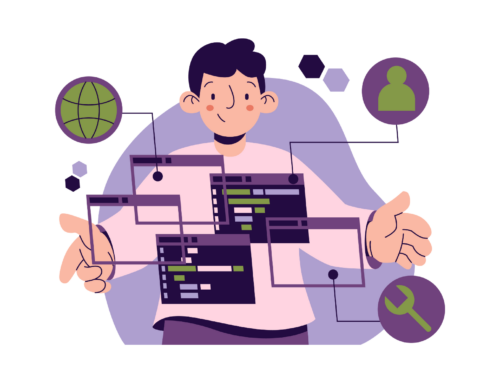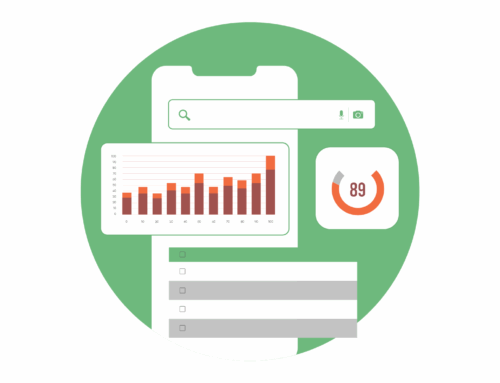I guess you’ve probably heard about this insanely revolutionized AI model multiple times over the past few months.
Since its launch, AI has taken over the world by storm, and people are looking at endless opportunities that AI can create.
No one has ever thought that AI would change the world completely upside down in just a few months.
And to be honest – it’s just the beginning.
ChatGPT won’t just help you to write a love letter for your crush, but it can totally change the way you do SEO.
In this post, we’ll be explaining how you can use ChatGPT for SEO in various different tasks to boost your productivity and increase your rankings massively.
So ready to dive in? Let’s jump.
Table of Contents
What is ChatGPT?
ChatGPT is a language model developed by OpenAI, based on the GPT-3.5 architecture.
It was initially launched on November 30, 2022, and since then, it has managed to acquire more than 100 million users in a very short span of time.
It’s designed to respond to natural language queries and generate human-like text based on the input provided by the user.
You can think of ChatGPT as your virtual AI assistant that can assist you with any query.
If you want to build an App, ChatGPT will write out code for you.
If you want to write content about a specific topic, ChatGPT will do that for you.
If you want to impress your crush, ChatGPT will give you ideas for that too.
No matter in what context you want information, ChatGPT will help you with everything, including SEO.
7 Ways to Use ChatGPT For SEO (Better Productivity And Higher Rankings)
AI can never replace you if you stop fighting against it and start working with it.
Using ChatGPT for SEO, you can not only increase your productivity by 10x, but you can get way better results in your SEO efforts.
Want to know how?
Here are the 7 proven ways to use ChatGPT for SEO.
1. Content Outline And Research
ChatGPT can not only help you with academic research, but it can also be your research buddy for creating insanely helpful content pieces.
One of the most time-consuming tasks of creating content is proper in-depth research. Without in-depth research, you can never create great content pieces.
Starting from generating a basic content outline to getting specific information about a particular section, you can do everything inside ChatGPT.
For example, if you just type in “create a blog post outline for the topic (insert your topic),” it will give you a basic outline that can be the base of your content.
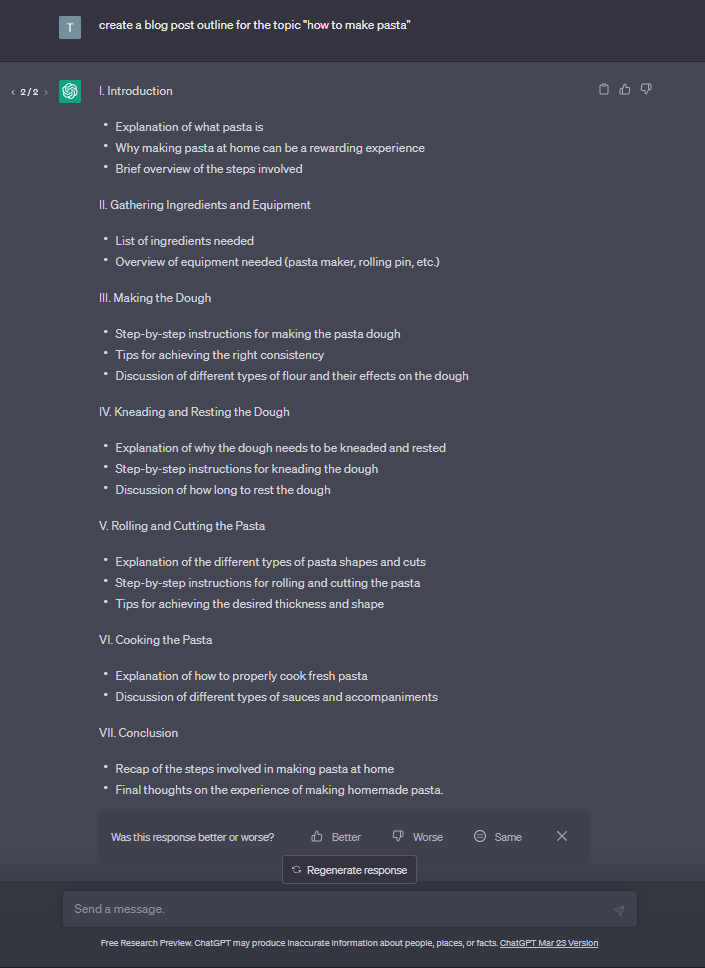
Of course, you would still have to edit the outline, but it serves as an excellent starting point. Editing the outline is far more time-effective than staring at an empty screen.
Similarly, if you want any specific information about a particular thing in a summarized way, you can just ask ChatGPT instead of scanning the internet.
As an example, if you want to know “How much sleep do humans need?”, just type out that question inside ChatGPT, and it will give you summarized information that’s far more easier to digest.
In short: if you’re still creating content without using ChatGPT, you’re just wasting a bunch of time on something that’s not worth it and can be easily replaced by AI.
2. Finding Content Topics
Finding content ideas can be hectic.
Especially if you don’t know what type of content your audience would love to consume.
There are tons of tools out there on the market, like AnswerThePublic, Ahrefs content explorer, and SEMRush, that help to find content ideas.
But to be honest, none of them are effective as they used to be.
Especially after the rise of AI.
Instead of jumping from website to website and in between multiple tools, what if I tell you that you can find hundreds of unique and creative content ideas using just one tool?
Yes, you guessed it right. It’s ChatGPT.
For example, if you have a CRM software company, you can simply ask ChatGPT to provide you with content ideas that people who use CRM software can potentially ask.
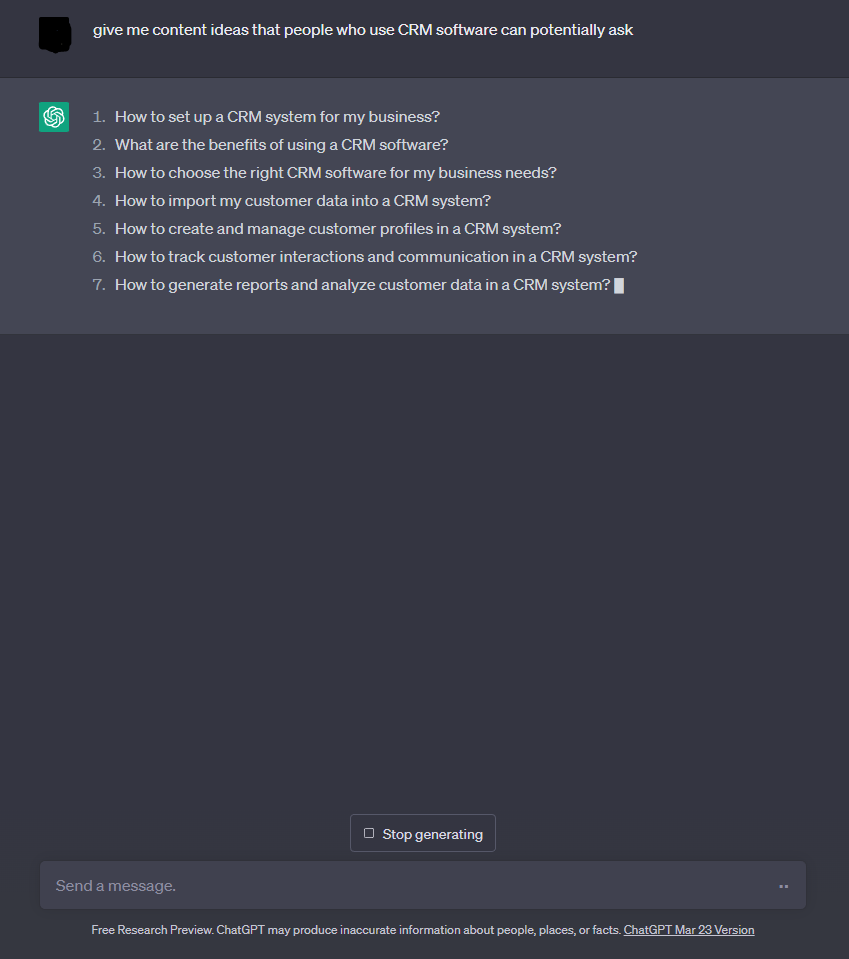
Of course, you can always play around with the prompts and generate more targeted content ideas that your ideal customers would love to read.
On top, you can even generate content ideas just based on specific keywords or any topics within your niche.
3. Keyword Research
Keyword research is the soul of search engine optimization.
Without proper keyword research, you can never create a compelling SEO strategy that wins in the search results.
But the truth is keyword research takes a lot of time.
However, now luckily, you can ask ChatGPT to give you related keyword ideas similar to the ones you’re targeting.
For example, If you head over to ChatGPT and ask it to generate keyword ideas related to the keyword “best USB microphone,” It will come out with tons of related keyword ideas that you can include in your content.
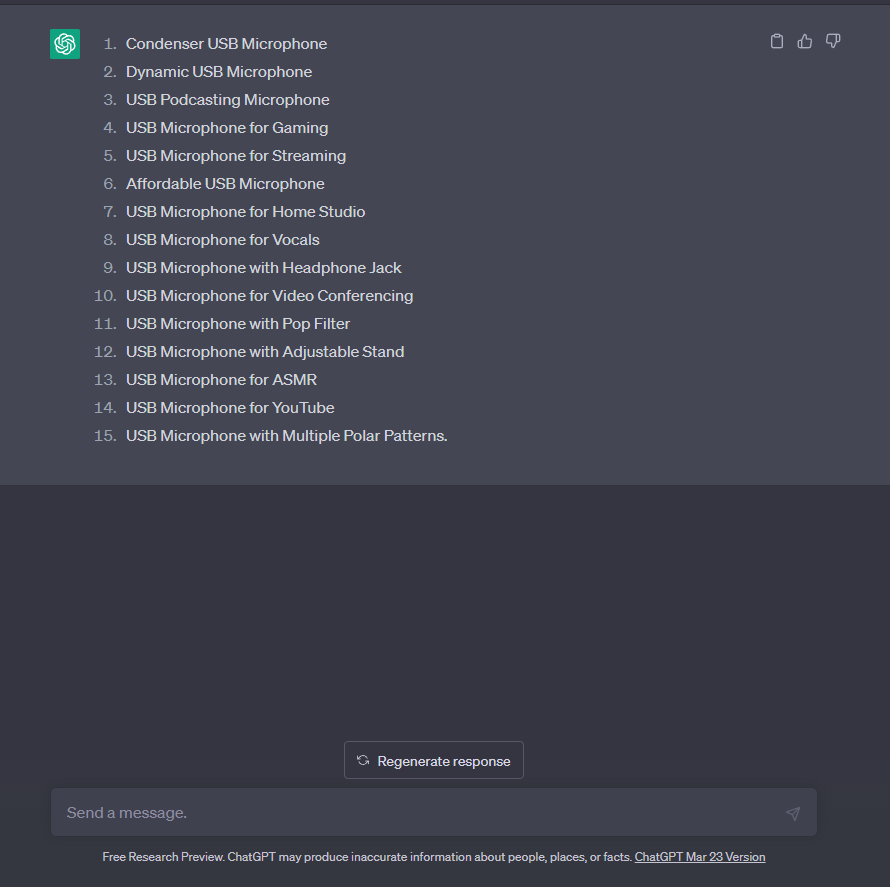
Of course, you can’t use all of these keywords within your content because some keywords might not be relevant to what you are writing about.
And some keywords might not have a decent search volume as well.
But it’s a good starting point.
ChatGPT can’t do all the work for you. You still have to cross-check whether the keywords would be the right fit for the content and check the search volume of the keywords.
For cross-checking the keywords, you can use the Zutrix keyword research tool.
Overall ChatGPT is a great place to find keyword ideas, but you would still have to filter out a lot to find out the keywords that will resonate with your content and SEO strategy.
4. Come up With Better Blog Titles For Higher CTR
8 out of 10 people will only read your headline and LEAVE.
Only 2 out of 10 people will actually read your content.
And that is a bulletproof fact.
In fact, copywriters like David Ogilvy also suggest that you should spend 50% of your time on coming up with a compelling headline and the rest 50% on writing the actual content.
Also, having a great headline helps you increase the CTR of your search result, which in return improves your search rankings.
But let’s be honest.
It’s not easy to come up with an effective headline.
However, you can use ChatGPT as your rescue and use the tool to come up with plenty of effective headline ideas that drive people’s attention and persuade them to read your content.
To do that, just head over to ChatGPT and enter the prompt:
“Write me multiple blog headlines for the topic [Insert specific topic here]. Also, make sure it’s attention-grabbing and short.”
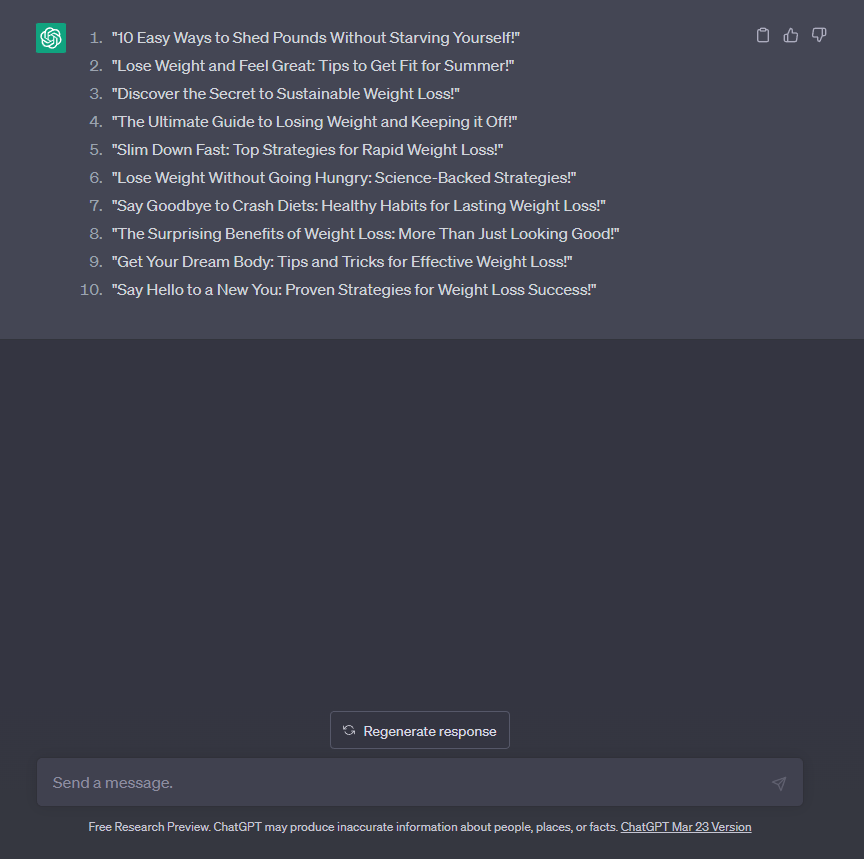
And ChatGPT will give you plenty of creative headline ideas that you can play around with.
5. Creating Content
Many people think that they can create high-quality content using ChatGPT and rank higher on Google search results.
But that’s not the case, to be honest.
See, most of the time, ChatGPT generates very generic content by summarizing the information it has because AI copywriting is still in the early stage.
Obviously, it’s definitely going to improve over time as AI progresses and educates itself, but for the time being, you can’t rely solely on ChatGPT for content creation.
Also, if everyone uses ChatGPT to write content and tries to rank for them, the internet is going to be filled with similar content, which obviously Google won’t let happen.
However, you can use ChatGPT to create a base for your content and then edit it extensively with your points of view and added information to make your content super valuable for the user.
Remember, no matter whether you write the content yourself or you let ChatGPT write it for you, your main goal should be to create valuable content that helps or educates your users.
6. Content Proofreading
We don’t know whether AI will ever replace creative work or not, but it will definitely replace all the time-consuming generic work.
And one of the time-consuming work that you can replace with ChatGPT is content proofreading.
Especially if you manage and work with freelance writers, proofreading their work can be a total nightmare.
And if you hire a good proofreader, it’s going to cost you a fortune for a single piece of content.
Instead, you can take the content and ask ChatGPT to proofread for any spelling or grammar mistakes.
But never ask ChatGPT to proofread all the content at once, as the results might not be good (especially if the content is lengthy).
Instead, you can take a specific part of the content and proofread it one by one.
And lastly, if you don’t like any sentences, you can even ask ChatGPT to rewrite them for you.
7. Create Email Outreach Copy For Backlink Building
One of our best use cases of ChatGPT for SEO is using it for generating email outreach copies for building quality backlinks at scale.
We have been personally using ChatGPT for our outreach copies, and until now, we’ve got phenomenal results.
Obviously, we had to personalize the email copy manually and but it’s totally worth it.
Conclusion
ChatGPT is your personal assistant that can take your productivity and SEO results to the roof.
You can use ChatGPT in various ways, as we’ve discussed throughout this post.
We personally use ChatGPT for almost most of the SEO tasks except content creation to increase our productivity and create exceptionally great content.
If you’re still not sure about whether you should use ChatGPT or not, you should definitely give it a try.
And we can assure you that you won’t ever look back again.

